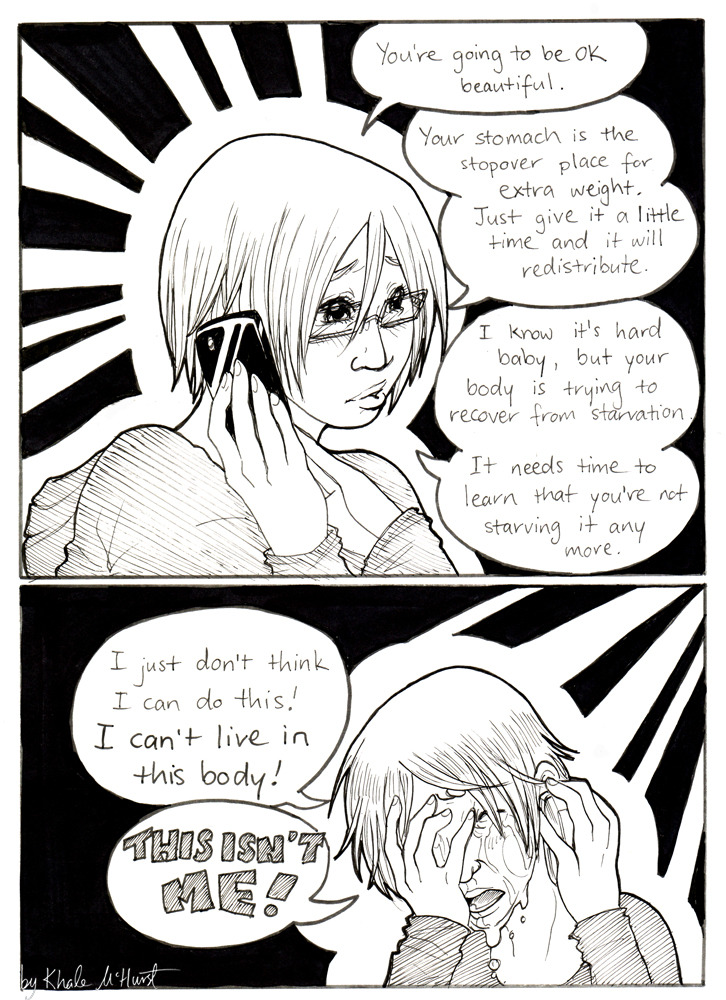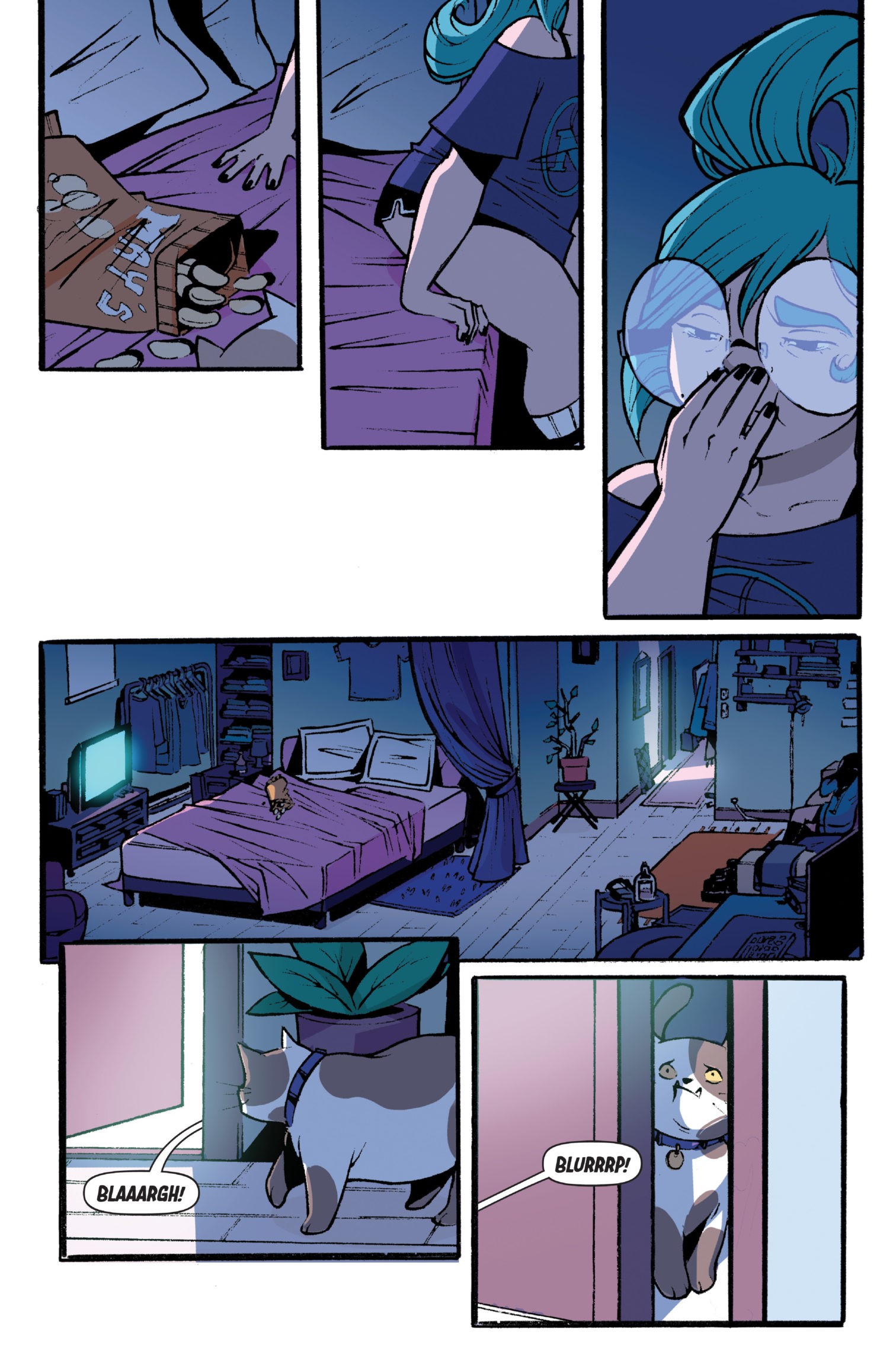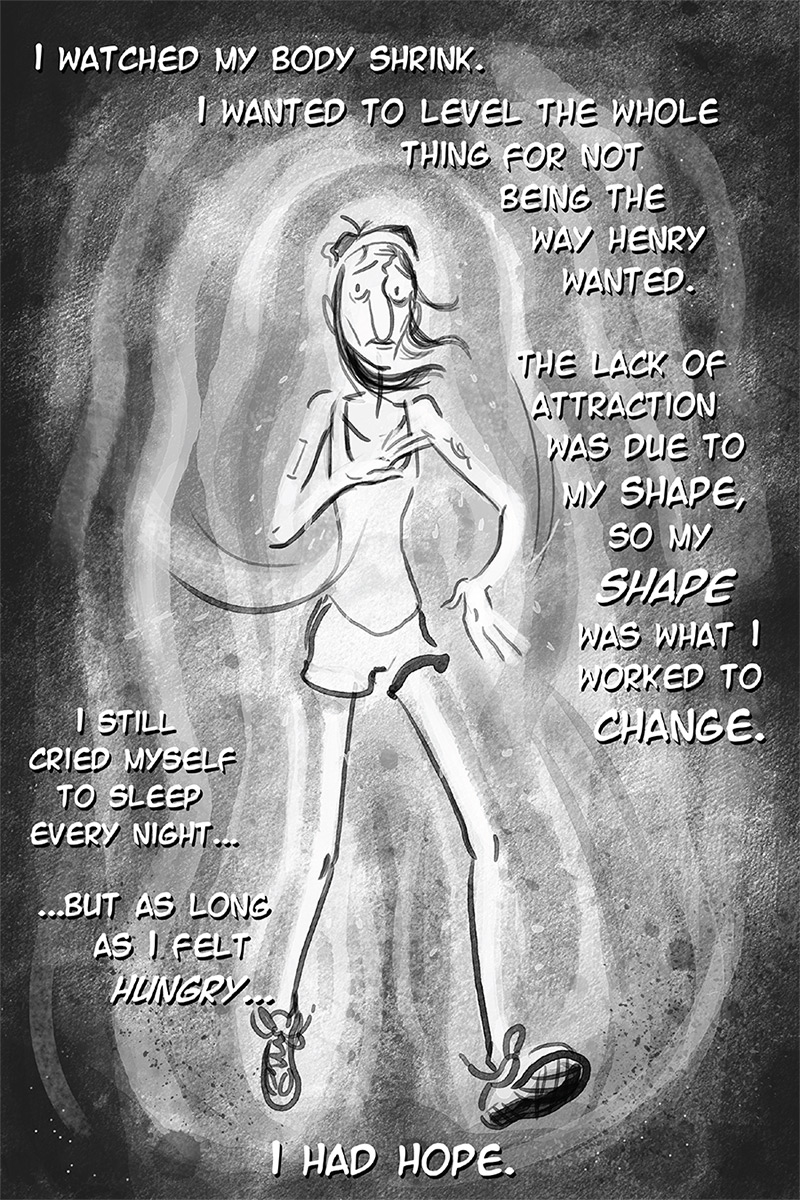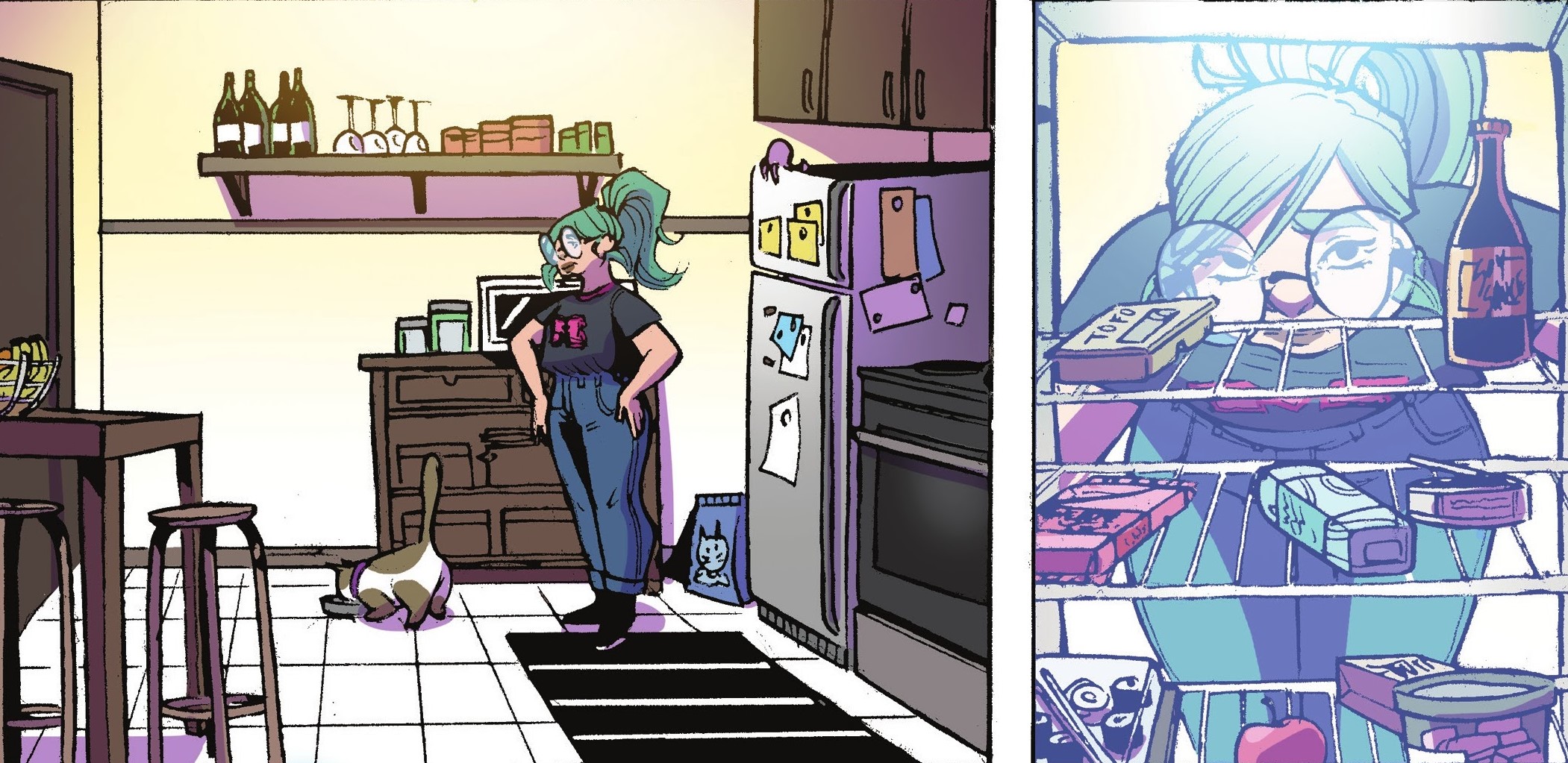Table of Contents Show
Because May is Mental Health Awareness Month, this month presents an opportune time to discuss the stigmatized disorders that fit under the umbrella of eating disorders. General trigger warning, this article will discuss various types of eating disorders represented in comics. There will also be illustrated depictions of the disorders, so be warned. While the topic can be mishandled across transmedia and literature, the webcomic I Do Not Have An Eating Disorder, the graphic novel Eat, and Love Yourself, and the illustrated comic memoir, Ink in Water, all accurately portray varying types of eating disorders and the mental health struggles that arise from these disorders.
The comic book medium proves time and time again that it is not solely relegated to superhero or comic strip presentations. Instead, these three comics invite their readers to take an unabashed look at a sensitive and personal topic that afflicts millions of individuals across the globe every year.
I Do Not Have An Eating Disorder
Written and illustrated by Melbourne-based Khale McHurst, her long-running webcomic, I Do Not Have An Eating Disorder, is an autobiographical account of her battle with anorexia nervosa. Along with fighting against disordered eating patterns, Khale’s webcomic fiercely chronicles her diagnoses for other mental health issues in her life. I Do Not Have An Eating Disorder examines how Khale’s eating disorder played a part in her battles with anxiety, bipolar disorder, orthorexia, body dysmorphia, and depression.
When Khale McHurst initially began writing and illustrating this story in 2013 as a form of art therapy and personal accountability as a part of her recovery process from eating disorders. As the webcomic progresses, readers see Khale’s perception towards her eating disorder morph through both the dialogue and the art style. Underneath each page of I Do Not Have An Eating Disorder, Khale writes a paragraph — or sometimes more — delving further into her thought process during the time period the webcomic page depicts.

Khale’s harrowing honesty is breathtaking. Three illustrated demons denote the voices of doubt and self-hatred continually screaming in her mind. Khale explains the disparity in her previous perceptions versus her current outlooks on the situations and mindsets she experienced — and is still learning to understand. Further, she admits that, on some pages, her art style did not meet her own personal expectations, but she accepts this as just a part of the emotional catharsis process of taking part in this webcomic project.
I Do Not Have An Eating Disorder describes multiple facets of living with an eating disorder with unflinching honesty. Khale’s webcomic depicts her during self-described low points of her life, but her fortitude proves itself by merely sharing her story for others online in the first place. Additionally, Khale includes links and resources for those wrestling with similar mental health disorders. She positively promotes therapy, even for those who may not feel financially stable. I Do Not Have An Eating Disorder magnifies the feasibleness of recovery — or beginning a path toward recovery — from eating disorders accessibly. She includes trigger warnings on pages that include suicidal ideation or NSFW imagery. Khale’s tear-jerking webcomic encourages readers while also relaying the harsh realities surrounding the eviscerating nature of mental health struggles.
Eat, And Love Yourself
Originally launched as a Kickstarter, popular indie comic publisher BOOM! Studios picked up and financed cartoonist Sweeney Boo‘s poignant graphic novel, Eat, and Love Yourself. Published through BOOM!’s comic imprint, BOOM! Box, Sweeney Boo’s comic is a tour de force from equal storytelling and artistic standpoints. She both wrote and penned the 150 paged graphic novel about a woman struggling with an eating disorder, body dysmorphia, and depression. Letterer David Hopkins provides the stellar lettering seen throughout Eat, and Love Yourself.
Protagonist Mindy feels like a disappointment. She’s 27 years old, works at a coffee shop, and is generally unsatisfied with her current status in life. While her parents don’t appear entirely ill-intentioned, her mother and father’s beratement of her looks, attitudes, and eating habits help push Mindy into a life filled with anxiety and body dysmorphia. Mindy’s relationship with food mirrors her relationship with herself; she binges in order to distract herself from her feelings of low self-esteem and then purges the food as a means of a quick-fix solution to forgetting her internal conflicts. When Mindy purchases a “healthy” chocolate bar eponymously titled “Eat, and Love Yourself,” the magic treat allows her to travel back in time. There, she looks on at her younger self, witnessing the triggering events that spiraled Mindy into a life of an eating disorder and removal of her belief in self-worth.

The heavy themes in Eat, and Love Yourself may prove triggering due to the nature of the subject matter. Boo manages to navigate the slippery slope of presenting weighty topics like eating disorder behavior in an age-appropriate way. Teenagers or even older children would be able to read this comic without being deterred by graphic renderings of binging — depicted off-panel in Boo’s book. Fortunately, Boo’s illustrations also maintain an atmosphere of levity. David Hopkins aids in intensifying the tone when necessary through oversized lettering and SFX screaming on the page. Primarily though, Boo chooses an endearing pastel color palette and utilizes thin lines to visually juxtapose the perceived versus internalized nature of Mindy’s eating disorder.
Eat, and Love Yourself spotlights a young woman with an eating disorder, but importantly, a woman who does not possess a “thin” body type. Binge eating disorders are absolutely not based on a visible body type, affecting individuals of all shapes and sizes. Eating disorders cannot be distinguished by appearance alone. Disorders do not discriminate based on certain factors, victimizing anyone and everyone. No real conclusion occurs in Mindy’s story. Eating disorders are not “thoughts” one can simply wish away. Instead, they are mental and physical illnesses to recognize, understand, and discover steps toward a hopeful, long-term recovery. Fundamentally, Sweeney Boo’s protagonist begins a beautiful journey toward self-love, self-actualization, and self-care in Eat, and Love Yourself.
Ink In Water: An Illustrated Memoir
Author Lacy Davis collaborated with her partner, illustrator Jim Kettner, to create the comic memoir Ink in Water: An Illustrated Memoir (Or, How I Kicked Anorexia’s Ass And Embraced Body Positivity). The graphic novel memoir reflects Lacy’s personal experiences with eating disorder behaviors through the unique lens of the high school punk scene and from a feminist perspective. Ink in Water details an autobiographical story about how an eating disorder can emerge from unexpected circumstances, and crucially, the commonality of relapses that transpire on the road to recovery.
Ink in Water focuses on many aspects involved with eating disorders, centralizing around life-threatening eating disorders bulimia nervosa and anorexia nervosa. Lacy Davis writes about how inundating, cultural depictions of body image acted counterintuitively to her own self-acceptance. Navigating life through the punk scene, she relates how it taught her to reject society’s beauty standards. Yet, a painful breakup and niggling thoughts surrounding beauty still managed to foster a negative body image perception in Lacy’s life. Like a drop of ink in water, the memoir graphic novel explains how Lacy’s idea of dieting equating to “health” spread until it consumed her mental and physical state of existence.

In Ink in Water, Lacy’s dialogue consistently associates engaging in disordered acts like purging and visiting harmful pro-ana sites with the feeling of emptiness. The juxtaposition of rationale and analytical thought processes also integrate poignantly throughout the memoir. At the same time Lacy boasted punk-feminist ideals that countered societal beauty expectations, she internalized an opposing belief system about her own body image. The punk-feminist point-of-view in Lacy’s memoir proves unique, thoughtful and also serves as a learning opportunity for unfamiliar readers.
Jim Kettner’s art builds on these themes from Ink in Water. Artistically, the watercolor-washed illustrations build on the comics’ main conceit of a drop of ink expanding in a cup of water. Greyscale tones and overwhelming black imagery portray life within Lacy’s eating disorder. Opposingly, a watery effect appears to disintegrate the harrowing ink-stain colors when Lacy writes about recovery. Every page of Ink in Water translates the concept perfectly. Lacy’s candid graphic novel teaches about the trauma of eating disorders, dealing with relapses, twelve-step recovery programs, and overcoming feelings of devouring powerlessness.
Learning And Understanding Eating Disorders Through The Comic Medium
No one book, essay, or documentary can wholly encapsulate the broad scope of eating disorder illnesses. Each of the three comics discussed, I Do Not Have An Eating Disorder, Eat, and Love Yourself, and Ink in Water, examine eating disorders and mental illness from varying frames of mind. Topics like body dysmorphia, purging, and depression overlap, but every author approached these subjects diversely. Ultimately, the comic medium presents an ideal means of communicating the multitudinous modalities of eating disorders through visuals and first-person dialogue. Whether discussing queerness, the long-term process of recovery, or life-altering moments within the eating disorder, these three comics compound the information provided through words with impressive artistry.
Comics often fall into the misconstrued category of “escapist literature.” While the term denotes many wonderful comics, serious subjects also demand an equal amount of consideration. Eating disorder experiences are not all-encompassing, and the comics here present an opportunity to consume a wide range of knowledge about the topic.
Please, always seek help if you are struggling. Here is a list of worldwide eating disorder resources and hotlines you can contact.
